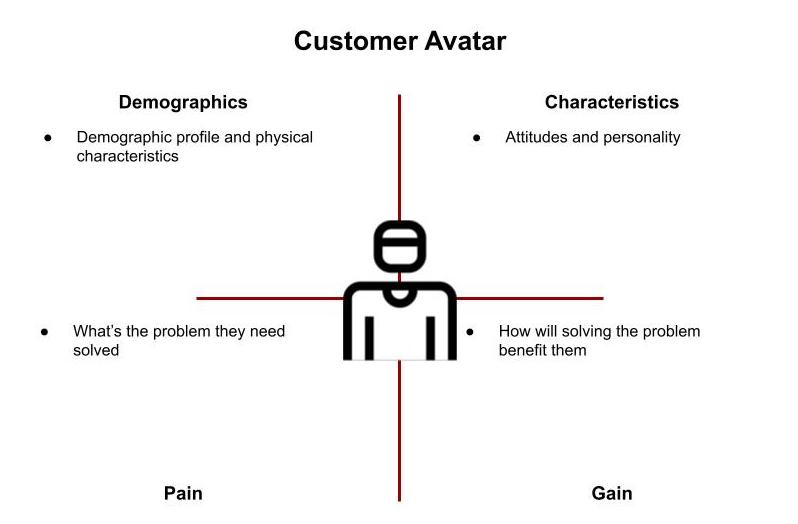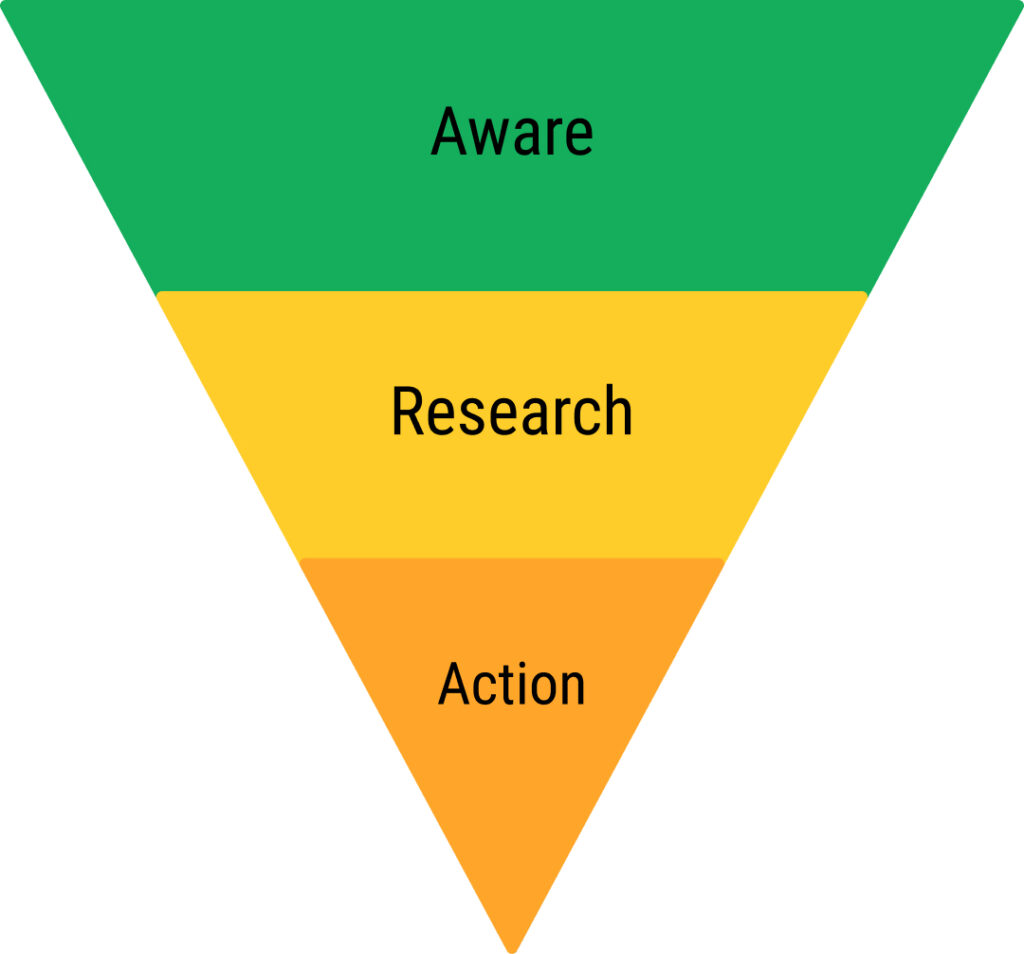Your cart is currently empty!

Three Steps to an Effective Business Website
Reading Time: 10 minutesAuthor:
When I audit websites, something I do a few times every month, the most common problem I see is an absence of strategy. Developing an effective business website doesn’t start with design or with the copy. An effective business website is the result of a thorough understanding of your target audience avatar and the journey they are on to solve their problem.
So, to ensure success, an effective business website starts outside of the website. It starts by using the customer avatar template to describe your ideal customer in four areas:
- What they look like demographically,
- What are their characteristics,
- What are the pain points they are trying to resolve, and
- What will be gained from working with the business?
Use this customer avatar template to describe your ideal customer. It will be useful for all your digital marketing efforts, but it’s especially useful for your website.
In addition to customer avatars, it’s important to map the journey undertaken by your target market; you want to understand the path they take in their mind before they get to your website and the journey they take on your website. Your marketing efforts should support this journey.
Once these things are settled, it’s time to start working on the website’s copy and design.
In the next section section, we’ll dig into the implementation steps to follow that will, in the end, deliver a more effective website for your business. We’ll look at the steps to an ideal customer avatar and, ultimately, a website that supports your ideal customer.
Implementation Steps to Deliver an Effective Business Website
We recognize that it’s satisfying to see images and copy on a page, but if your goal is to have a website that will generate value for your customers and your business, then this starts with strategy. And strategy starts with a deep and complete understanding of your ideal customer, who they are, what they are looking for, and how you solve their problems.
Effective digital marketing supports your best customer’s journey in a way that builds trust versus focusing on getting the sale at all costs. As we’ve written before, “90% of loyalty problems can be traced to a flawed sales process.“
The pivot point, the fulcrum that maximizes the impact of your digital marketing campaigns, is your website. This is where your ideal customer avatar interacts with your business.
Build Customer Avatars for Each Target Audience Segment

A customer avatar is a useful planning tool that’s useful for many things. It can be used to develop and refine products and services. It’s also used to set the content messaging strategy. When content is created to serve the needs of a customer avatar, your ideal customer will see your digital marketing and engage with your content. This approach will create value for your target audience because it’s focused on topics that matter to them.
Consider our blog and this blog post. Inn8ly’s ideal customer is a six-figure business owner who is using or wants to use digital marketing to drive business growth. We write about digital marketing and tie our content back to the importance of an effective business website to attract our ideal customers. Our content matters to our customer avatar.
Best Customer Avatars
One other point here. Your customer avatar should be based on your best customers. In virtually every category, a minority of customers in the category generate the majority of category sales. These customers are very knowledgeable. They have a significant need for what the category offers. They also understand your offer and your competitors’ offers. It’s a common mistake to target the average customer when the opportunity is with ‘best customers.’ Keep this in mind when you are creating customer avatars for targeted marketing.
Create Multiple Avatars
You will likely create multiple avatars. One customer avatar should be created for the broad target audience. If you can effectively target with one target audience avatar, then that’s all you need. But if, as is true in most situations, there are subsegments among your existing customers with unique needs, then you will need multiple avatars. But don’t get crazy. There should be no more than four avatars: the broad avatar that describes your target audience and two to three avatars for key target market subsegments.
As I briefly described above, a detailed customer avatar has four quadrants: demographics, characteristics, pain points, and gain.
Target Audience Demographics
This is where you describe your best customers’ physical characteristics. How old are they? What’s their gender? What’s their marital status? Their job title? Their average household income? Anything that helps describe what your target audience looks like.
This is useful when selecting media channels. If your ideal customer is older, chances are they aren’t using TikTok.
Understanding demographics also helps with website design. High contrast is very important if your target audience is older. A feminine look & feel will be key if your audience is women.
Target Audience Characteristics
How do they think about things? Are they conservative? Are they open to new ideas? Are they practical? Understanding their characteristics and the things that make them unique lets you craft content that engages your ideal customer by reinforcing their ideas and supporting their journey.
Note the words I used, “reinforcing their ideas” and “supporting their journey.” Best customers already know what your product or service offers. Recognize and build on this. Don’t spend precious time (attention) telling your ideal customer what they already know. Understanding and supporting their existing attitudes makes all your content more effective.
This is especially true on the website. An effective website isn’t the start of their journey. It’s a mid-point in their journey. Your website should be a fulcrum that demonstrates your understanding of their pain points and supports their journey.
Target Audience Pain Points
This is where you define their problems. What is the problem that your target market is trying to solve? This is vital. And it’s the most common mistake I see when I audit websites. Inside-out copy that talks about the business is a missed opportunity. Outside-in copy that recognizes and empathizes with your best prospect’s pain points is more effective.
By understanding and listing your best customer’s problem, you can create marketing strategies and website copy that demonstrates that you understand their challenges. The PAS copy framework (Problem, Agitate the problem, Solve the problem) is popular for a reason. It works and is especially effective on a website.
Leading with target audience pain points results in engagement. If you don’t have engagement, your other marketing efforts are just more noise in the background. Engagement starts with solutions to real problems. Write them down.
Target Audience Gain
Now that you understand the detailed profile of your target market, their demographics and characteristics, and the problems they are trying to solve, you can list your solutions. You can describe how you will solve their problems. You can describe what your ideal customer gains from your products or services.
Be sure that what you place in the gain quadrant tracks back to the other quadrants.
The Customer Avatar

The order is important: demographics, characteristics, pain, and gain, but the connection between the four quadrants is what makes the customer avatar template the effective and powerful tool it is. We explore this in more detail in our article about the non-icky marketing funnel.
The four quadrants also inform all of your content marketing efforts. The detailed customer avatar brings your buyer persona to life. And don’t stop at one. Multiple customer avatars will be required to capture the multiple market segments that reflect your target market.
Describe the Customer Avatar’s Journey
Having a well-crafted and detailed customer avatar is very valuable, but there’s another equally important step required to maximize the impact on your marketing efforts. And this is likely a big opportunity for you. Most of your competitors don’t have this piece.
Mapping your ideal customer’s journey lets you capture their thought process in a way that you can use to make decisions about content channels, messaging, and offers. What are their questions? What are the obstacles blocking their pathway forward? By mapping the customer journey and having a customer avatar, you can get the right message to the right person at the right time.
The goal is to encourage and draw your best prospects along their journey in a way that supports the decisions they need to make. Being supportive builds trust. You do this by offering your ideal customer avatar opportunities to engage with your business. Plan for micro-transactions of increasing value that follow your customer avatar’s journey.
Marketing efforts that follow this strategy will be more effective because they understand and support the buyer’s journey. But this cannot be accomplished without a complete picture of the buyer persona that is your ideal customer. This is why both are important. You need the customer avatar and the buyer’s journey.

Struggling to Connect with Your Ideal Customers?
Stop Wasting Time & Money on Ineffective Campaigns.
Pinpoint Your Audience with Our Free Customer Avatar Template!
The Customer Avatar and Journey – a Quiz Funnel Use Case
As mentioned above, digital marketing strategies need to consider the customer avatar and the journey to be successful. For example, an especially effective way to use the customer avatar and journey is the quiz funnel.
A fun quiz is used as a top-of-the-funnel lead magnet. The quiz will attract and engage prospects as their interest in the category is piqued. It also tells you about the prospect.
The quiz is a good example of the microtransaction strategy. The first microtransaction is completing the quiz. This is low value in that it only requires a bit of time. In exchange, the consumer is being entertained.
But to see the results, a user needs to provide their email address. This microtransaction has greater value and suggests that the consumer is more engaged. You can now use email marketing campaigns and Social Media marketing, organic and paid, to nurture the new relationship and draw them along their journey.
You know what to say because you’ve captured their pain points in the customer avatar. In addition, the quiz has highlighted their interests. Craft an email marketing automation to build on these insights.
A botton-of-the-funnel assessment survey can be used to encourage qualified prospects to take action. This is an efficient way to close the funnel and is especially effective for high-value sales.
With customer avatars and journey maps, your digital marketing will attract your ideal customers and create value for them and for your business.
Get the right message to the right person at the right time.
Implement the Customer Avatar and Journey on Your Website

Now we’re into the fun part. With a solid understanding of your buyer persona, you will be able to craft an effective website, a website that will create value for your customers and your business.
In another post, Six Ways to Convince Website Visitors to Stay, in Six Seconds or Less, we describe the six areas that need to be considered for every page on the website, but especially for the home page. The third way is to give them a benefit-oriented reason to stay, and the fourth is to make their path clear. Both these areas will be heavily influenced by the customer avatar and buyer’s journey.
Give Them a Benefit-Oriented Reason to Stay
When someone arrives on the website, their journey starts with engagement. Don’t talk about yourself. Talk about your ideal customers. When a visitor recognizes that you understand their problem, they will pay attention. If they don’t believe you understand their problem, they will likely bounce, and the opportunity is lost.
It can also be effective to agitate the problem. Describe what might happen if the problem isn’t solved. This isn’t essential, but when it’s used effectively, it further engages the visitor.
Then, you can offer a solution and/or pathways for subsegments within your target market or audience.
People buy benefits. They buy solutions to their problems. Don’t hammer away at what you do; they got there because they know your brand; they know what you do. Don’t talk about all your services. You’re asking them to think, to fit what you do into their world. They won’t do this. Give them a pathway that’s unique to who they are. Support their journey.
Make Their Pathway Clear
In the avatar section above, we described creating multiple avatars for each of the subsegments within your target audience. Pathways is where this becomes very useful. Use the customer avatars you created to craft people-like-you doorways for each of your key subsegments.
When you make their pathway clear, and they click through to a page that’s been carefully crafted to address their unique needs, two very important things have happened: they are telling you exactly who they are, and they’re giving you permission to give them more information.
These pathways should be immediately below the hero/intro section. Each path’s is-this-you headline should be visible without needing to scroll. Images can be used to visually emphasize what makes each path distinct. A sentence or two of enticing copy that communicates the benefits they will receive by clicking through to the next page will help. Use a CTA button to make it easy to take action.
What Else Can You Do?
There are a number of other things you can consider depending on your situation and the needs of your ideal customer.
Social proof provides a rational reason to believe your offer, to believe that you can deliver the proposed solution. Showing the logos of the many businesses that you work with is an effective form of social proof, especially if they are major brands. Five-star ratings and targeted testimonials will also effectively support the validity of your claims.
Show recent blog posts if they are, in fact, recent and they support your authority.
Don’t shove stuff onto the page just because you can. Think about obstacles that might be in your prospect’s mind where they are in their journey. Use the pathway landing pages to overcome them.
Each and every element on every page should be carefully considered and assessed as to its ability to attract and engage your customer avatar and support their journey. If it’s not a great fit. Don’t use it.
Create a Customer Avatar and Map Their Journey for Effective Marketing Strategies
Three Steps to an Effective Website

Effective marketing strategies start with understanding your ideal customer and, by proxy, your target audience. Use a customer avatar to capture a detailed profile of who they are, how they think, their challenges and pain points, and their gain from working with your business.
Map your customer’s journey. What triggers their interest? What are the questions they will ask? Use the customer avatar and journey to create a marketing funnel that nurtures and supports your ideal customer. Use your understanding of their journey to design and structure the content on your website. Be focused. You have six seconds or less to engage website visitors and draw them to a sale.
Use the insights gained to craft digital marketing and website copy that supports their journey. Don’t talk about yourself; talk about them and their problems. A customer avatar plus up to three sub-segment customer avatars, if you have subsegments, and a buy’s journey map are useful ways to capture what’s important to your best prospects and when it’s important.
Related Posts
-
Use the ChatGPT Model That Matters
See how using the right tools (models) balances quality and cost.
-
Marketing Strategy Mistakes to Avoid
Discover the 12 common marketing strategy mistakes that can hinder growth.
-
Your Marketing – A Pile of Parts or a Wheel?
Your marketing isn’t missing effort—it’s missing connection. Making connections turns scattered tactics into momentum.
Author: James Hipkin
Since 2010, James Hipkin has built his clients’ businesses with digital marketing. Today, James is passionate about websites and helping the rest of us understand online marketing. His customers value his jargon-free, common-sense approach. “James explains the ins and outs of digital marketing in ways that make sense.”
Use this link to book a meeting time with James.
